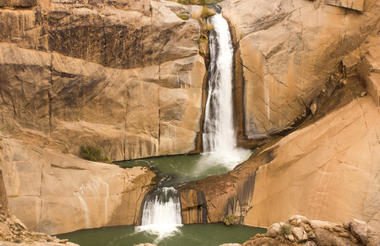One of the most culturally and geographically diverse places on earth, South Africa, fondly known by locals as the 'Rainbow Nation', boasts 11 official languages, and its inhabitants are influenced by a fascinating mix of cultures. Discover the gourmet restaurants, impressive art scene, vibrant nightlife, and beautiful beaches of Cape Town. Enjoy a local braai (barbecue) in the Soweto township, browse the bustling Indian markets in Durban, or sample some of the world's finest wines at the myriad wine estates dotting the Cape Winelands. Some historical attractions to explore include the Zululand battlefields of KwaZulu-Natal, the Apartheid Museum in Johannesburg, and Robben Island, just off the coast of Cape Town. Above all else, its untamed wilderness is astonishing: wildlife roams freely across massive unfenced game reserves such as the world-famous Kruger National Park.
Located in South Africa’s Northern Cape Province, the Augrabies Falls National Park encircles the mighty Augrabies Falls. The Orange River plunges down 60 metres in absolute splendour, through the 18-kilometre ravine of the Orange River Gorge. The landscapes are characterised by rocky outcrops, scrub-dotted plains, and clusters of 'kokerboom', also known as quiver trees. This sanctuary provides a home for an array of animals including springbok, gemsbok, klipspringer, various bird species and the endangered black rhino. Other commonly spotted species include giraffe, steenbok, kudu, eland, leopard, African wild cat, jackal, and caracal.



With its well-developed infrastructure, some of the best tourist facilities in Africa and an impressive list of breathtaking natural wonders, touring Namibia is truly a pleasure. Visit the capital of Windhoek and the lovely coastal town of Swakopmund to discover remnants of the country’s German influence, reflected in the architecture, culture, cuisine and the annual Oktoberfest celebrations. To properly appreciate this extraordinary country, you will have to venture out of the cities to explore the remarkable natural landscapes Namibia has to offer. These include: the impressive Fish River Canyon Park; the vast Etosha National Park teeming with local subspecies, such as desert lions, desert elephants and the Hartmann's Mountain Zebra; the hauntingly beautiful Kalahari Desert; and of course the Namib Desert stretching for nearly 1000 km along the magnificent Atlantic coastline. Namibia is an ideal destination for travellers seeking an unforgettable African experience in a uniquely beautiful untamed wilderness.
The Fish River Canyon is the most impressive natural wonder in southern Namibia. The canyon starts near Seeheim in the lower reaches of the Fish River and ends 160 km further south at Ai-Ais. It is an awe-inspiring gorge that meanders through the fissured Koubis massif at a depth of up to 550 metres. The Fish River Canyon is the second largest canyon in the world.
The canyon started to form about 500 million years ago during a pluvial episode – i.e. a period of intense rainfall. The huge gorge was not only created by water erosion, however, but also by the collapse of the valley bottom due to tectonic movement and by glaciation during the Karoo Ice Age.
The Fish River Canyon is part of the Ai-Ais/Richtersveld Transfrontier Park. The entrance gate is at the Hobas Campsite, from where it is 10 kilometres to the canyon and the most stunning view of the famous Hell's Bend.
The 86 km Fish River Canyon hike is very popular. But it is a tough challenge of 4-6 days and aspiring hikers have to prove their physical fitness with a medical certificate when they apply for a permit from Namibia Wildlife Resorts in Windhoek. Due to soaring temperatures during the summer months, the trail is open only from May to September.
Much easier, but no less scenically beautiful hikes are offered in the adjacent private nature reserves Canyon Nature Park and Gondwana Canyon Park, which also have excellent accommodation.



Tucked away in the rocky Aus Mountains on the fringe of the Namib plains, the small village of Aus is located in the south-western ǁKaras Region. The arid surroundings are known for their unique botanical diversity. Aus lends itself as an excellent base from which to explore the area and view the main attraction: the feral horses of the Namib Desert, which run wild and free on the sparsely vegetated plains. Catch a glimpse of these desert-adapted creatures at the water trough at Garub just 20 km away from the village.
Activities: Experience the Succulent Karoo on a visit to the beautiful Gondwana Sperrgebiet Rand Park, home to the most biodiverse desert in the world; take a scenic hike to discover fascinating indigenous fauna and flora; view the vast desert landscape from the back of a horse; camp under the dazzling Namibian night sky.



The desert town of Solitaire, in the south-western Khomas Region of central Namibia, is like a small oasis. There is not much to do or see in this tiny village, other than stop for refreshments and filling up with petrol. Solitaire boasts the only petrol station, general store and post office between Sossusvlei and Walvis Bay. There is also a small bar and a bakery famous for its apple pie – said to be the best in the country – as well as a luxury lodge, a motel and a campsite.
Activities: Enjoy a scenic sundowner with spectacular views of the Namib Desert; take time for a hike; go biking through unspoilt natural scenery; visit the local cheetah sanctuary.
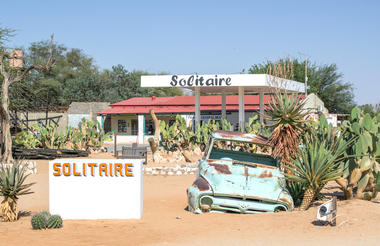
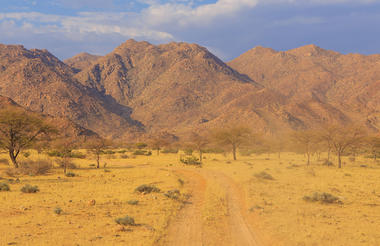
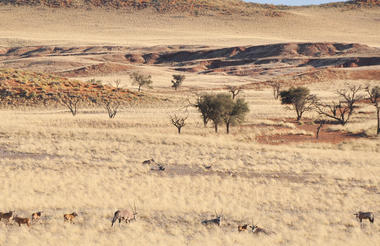
As previously described

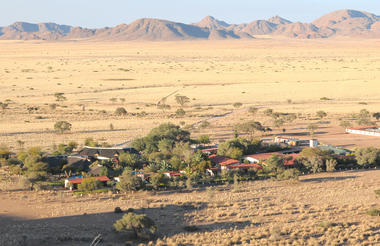
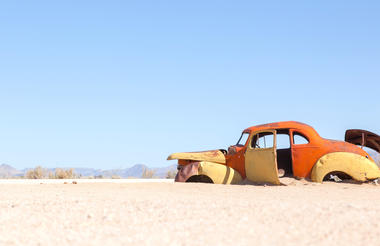
In 1892, eight years after South West Africa was declared a German Protectorate, Swakopmund was founded with the intention to build a harbour. By 1907 a little town pulsating with life had emerged from the desert! Swakopmund boasted the largest European population of all the German colonies in Africa. Decades on and much bigger now, the charming town is as alluring as ever. The mix of Namibian influences with picturesque buildings from the colonial era, palm-lined streets and seaside promenades, the laid-back holiday atmosphere plus the cool sea breeze make Swakopmund one of the most attractive places in the country.
Despite the turquoise waters of the Atlantic Ocean on its doorstep and the Namib Desert as its backyard, Swakopmund is not a tropical sunbathing paradise, however. The moderate climate along the coast is due to the cold Benguela Current. The current also causes the nightly fogs for which the town is famous and which sustain the wealth of desert flora and fauna near the coast. Early mornings and the evenings can be chilly throughout the year – a welcome respite from the inland heat.
Swakopmund has become the country’s adventure mecca. The desert, the dunes and the ocean lend themselves to a host of thrilling activities: sandboarding, sand skiing, quad biking, dune carting, beach angling and deep sea fishing, to name but a few, and not to forget parachuting.
There is no shortage of diverse shops, bistros and restaurants. Small specialist shops sell hand-made leather work, art & crafts, hand-woven carpets and wall hangings, hand-embroidered bed and table linen and other items proudly made in Namibia. Superb jewellery, designed and crafted with local gemstones by master goldsmiths, are another special feature of Swakopmund.
Activities other than fun in the sand and the sea: visit the art galleries and buy contemporary Namibian art and crafts; visit the museum to learn about Swakopmund’s history; join a tour of Karakulia Weavers and watch karakul wool being spun and woven into wall hangings and rugs; admire the world's largest quartz crystal cluster and other mineral treasures at the Kristall Galerie.
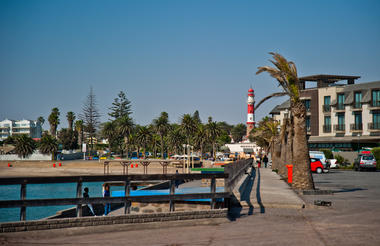


Palmwag Lodge, halfway between Swakopmund and Etosha, is idyllically located among tall Makalani palm trees on the banks of the seasonal Uniab River. It is one of Namibia's oldest and most popular tourist destinations. The availability of water often lures elephants closer to the lodge. Palmwag manages the concession area around the lodge, a vast nature park of 5500 km² which boasts the largest predator populations outside Etosha National Park and most of the world’s free-roaming Black rhino. There are also healthy numbers of the legendary desert-adapted elephant as well as mountain zebra, giraffe, springbok, kudu and more.

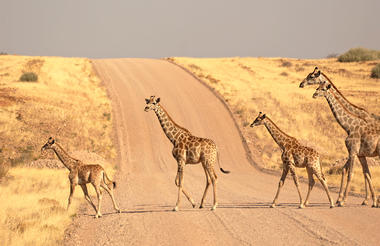
Etosha National Park in the central north is world-famous for its abundance of wildlife and premiere game viewing opportunities. The park is home to 114 species of mammals, including elephants, black rhinos, lions and other big cats and predators, giraffes, various antelopes and zebras, as well as hundreds of species of birds and reptiles. The vegetation ranges from dense bush to open plains with semi-arid savannah grasslands. During the dry season and in times of drought, the animals flock to the perennial springs and artificial waterholes which are maintained all over the park.
Etosha Pan in the heart of the nature reserve is a vast shallow depression of 5000 kilometres2 that can even be seen from space. The huge salt pan is dry for most of the year and lies shimmering in the heat, but after good rains it fills up with water and attracts scores of birds, especially flamingos from as far away as the Walvis Bay Lagoon on the Atlantic coast.
The western reaches of Etosha are quite different from its south-eastern and eastern parts. Even the characteristic white dust of the pan gives way to reddish-brown soil. The hills of western Etosha are the realm of Hartmann’s Mountain Zebra.
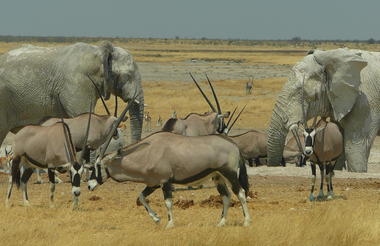
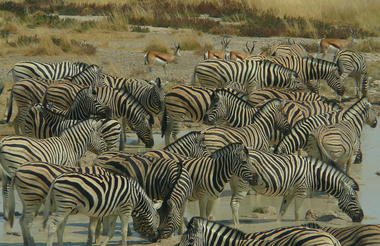
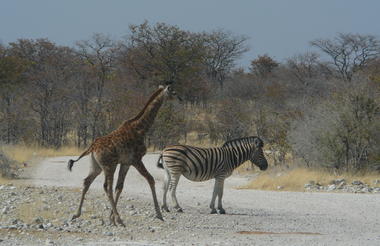
The Kalahari Basin covers most of Botswana and large parts of Namibia and South Africa. The name Kalahari means 'the great thirst' and describes the world’s largest continuous area of sand. It is an exceptionally beautiful semi-desert. In Namibia it is characterised by red dunes, acacia trees and wispy, mostly golden grass. The wide variety of wildlife includes gemsbok, impala, jackal and cheetah, not to forget the famous Meerkat. In all three countries the Kalahari is the last bastion of the indigenous San people who lived as hunter-gatherers in the whole of southern Africa before the modern world started to take over.


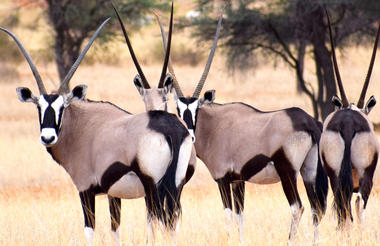
One of the most culturally and geographically diverse places on earth, South Africa, fondly known by locals as the 'Rainbow Nation', boasts 11 official languages, and its inhabitants are influenced by a fascinating mix of cultures. Discover the gourmet restaurants, impressive art scene, vibrant nightlife, and beautiful beaches of Cape Town. Enjoy a local braai (barbecue) in the Soweto township, browse the bustling Indian markets in Durban, or sample some of the world's finest wines at the myriad wine estates dotting the Cape Winelands. Some historical attractions to explore include the Zululand battlefields of KwaZulu-Natal, the Apartheid Museum in Johannesburg, and Robben Island, just off the coast of Cape Town. Above all else, its untamed wilderness is astonishing: wildlife roams freely across massive unfenced game reserves such as the world-famous Kruger National Park.
Combining the former Kalahari Gemsbok National Park of South Africa and the Gemsbok National Park in Botswana, the enthralling Kgalagadi Transfrontier Park is a wonderland of bright orange dunes, spectacular wildlife and fascinating flora. This hauntingly beautiful desert land is part of Africa’s first transfrontier park, ensuring that conservation is the top priority for this vast ecosystem and its inhabitants - it also supports and protects the indigenous people here, the ‡Khomani San and Mier communities. Visitors can look forward to spotting lions, leopards, hyenas, cheetahs, blue wildebeest, springbok, eland, and more than 200 bird species, including migrating flamingos and pelicans, and numerous raptors. Some of the activities on offer include game drives, 4x4 excursions, hiking, swimming, eco trails, star-spotting and nature photography.



As previously described



As previously described
Originally called Olijvenhoutsdrift, the historic town of Upington is set in the Northern Cape Province of South Africa. The Orange River Valley runs through the harsh and mysterious Kalahari landscape that surrounds Upington and it becomes obvious why this area is known as the Green Kalahari, with fertile valleys contrasted against semi-desert. Upington offers lush manicured gardens, stately trees lining wide boulevards and colourful flowers, creating a sense of peace and serenity. Meanwhile, the town’s bustling business centre provides visitors with more lively entertainment. Upington serves as the gateway to the impressive Augrabies Falls and to the expansive wilderness of the Kgalagadi Transfrontier Park. Visitors can learn about local history at the Kalahari Orange Museum, enjoy wine tasting at the local Orange River Wine Cellars, or take a sunset cruise down the Orange River on a floating bar.

